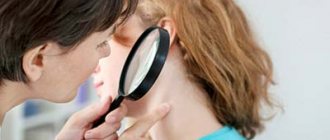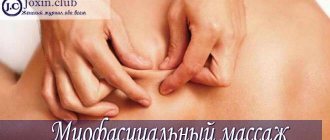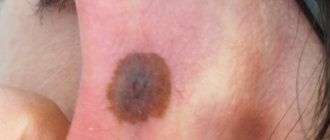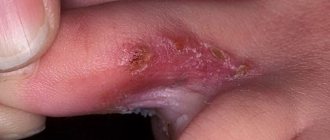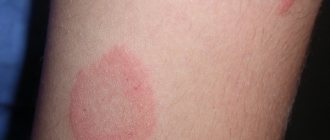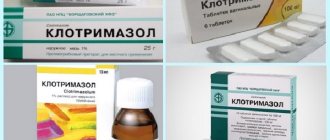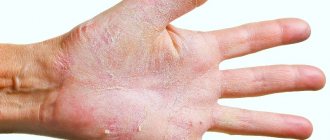Kinds
Depending on the course of the disease, the following forms are distinguished:
- typical;
- complicated or folliculitis;
- lichenoid.
Itching, large scaly plaques of yellow-brown, red or brown color with clear boundaries are characteristic of the typical form. The complicated form is characterized by severe erythema and profuse eruption of pustules and papules. The lichenoid form is characterized by areas of lichenization of the skin. Men are most often affected by this condition.
Infection occurs during initial contact with a sick patient, but more often through objects that were previously used by this person (thermometers, underwear, washcloths and oilcloths).
Causes
The cause of this disease is infection with fungi. Factors that can trigger the development of the disease:
- high ambient temperature;
- obesity;
- increased sweating;
- disturbance of carbohydrate metabolism;
- high air humidity;
- damage to the surface layer of the skin: maceration, minor abrasions and scratches.
Mycosis of the groin - what kind of disease is it?
Mycosis of the groin is an infectious disease typical of men. This part of the body is an ideal breeding ground for microorganisms that like high temperatures and humidity.
Interestingly, mycosis of the groin in men very often occurs simultaneously with mycosis of the foot. Men who daily wear tight underwear made of artificial, airtight materials are especially susceptible to this.
The skin reaction caused by a fungal infection is very unpleasant due to its location. In fact, with every movement, friction occurs and sweating increases. This, on the other hand, increases the risk of developing infection and exacerbation of the existing disease. In addition, itching and discomfort are felt almost all the time, making it difficult for patients to carry out their daily duties and function normally.
Inguinal mycosis - causes of the disease
Epidermophyton floccosum and Trichophyton rubrum are the most common fungi that cause inguinal mycosis. These fungi from the group of dermatophytes most often affect the skin, hair and nails. Infection with them can occur as a result of both direct and indirect contact.
However, it should be remembered that in a healthy body, mycosis of the groin will not develop. Pathogens do not attack healthy skin. Therefore, only when the body is weakened, for example due to another chronic disease, fungi penetrate the skin and the first symptoms of the disease appear.
Factors contributing to mycosis of the groin include: • Obesity. • Diabetes mellitus • Excessive sweating. • Insufficient personal hygiene. • Wearing underwear that is too tight and does not breathe. • Weakening of the body. • The occurrence of other chronic skin diseases.
It is worth noting that groin mycosis is not a primary disease. It develops due to another disease, which very often is athlete's foot.
The fact that inguinal mycosis is much more common in men is due to their anatomical structure. It is in this part of the body that increased sweating is observed, due to which microorganisms receive excellent conditions for development and reproduction. In men, the scrotum additionally touches the inner thighs, which further complicates the ventilation of the skin in this area, as well as the healing of existing wounds.
Because fungi thrive best in moist environments, it is easy to become infected in places like gyms, health clubs, swimming pools or even saunas. Germs can live in them, even on benches, towels or sweaty clothes. Therefore, it is not surprising that inguinal mycosis is a typical sports disease.
Treatment of inguinal athlete's foot
Therapy depends on the form and stage of the disease. As a rule, at initial and moderate severity, the patient is prescribed local treatment in the form of antifungal drugs:
- Sulfuric ointment:
- Econozol;
- Mycoseptin;
- Clotrimazole;
- Micofungin;
- Ciclopirox and others.
In addition, antihistamines are prescribed to relieve debilitating itching:
- Loratadine;
- Tavegil;
- Suprastin, etc.
In the acute stage of inguinal athlete's foot, treatment at the first stage involves drying the inflamed areas using lotions of 1% resarcin solution or 0.25% silver nitrate solution. Ointments are also used for this purpose:
- Triderm;
- Mycozolon.
Only after acute inflammation has been relieved are antifungal agents prescribed. If the disease is complicated bacterially and purulent growths are observed, then the doctor must prescribe antibiotics.
Local preparations are applied to inflamed areas 2 times a day. The course of treatment is at least one month.
If the nail plates are affected by inguinal epidermophytosis, they are removed, and the nail bed is treated with fucarcin or brilliant green, then the above-mentioned antifungal drugs are used.
It must be remembered that during the healing process, thorough disinfection of the patient’s belongings is mandatory.
To avoid relapses, the course of therapy should include not only medication, but also a number of preventive procedures.
Mycosis of the groin - symptoms
In the case of inguinal mycosis, the lesions usually appear symmetrically on both sides. However, at the initial stage of development of this disease, it may happen that the first symptoms appear on one side first. These lesions are usually round, erythematous, and produce an inflammatory response with desquamation. Often, papules and pimples also appear on the periphery of such a lesion, clearly demarcated from healthy skin.
The most important and characteristic symptoms of inguinal mycosis are: • Round, erythematous spots of irregular shape, accompanied by papules and blisters. • Visible peeling or cracking of the skin within the lesions. • Feeling of uncleanliness, unpleasant odor. • Scratches, skin changes in the form of fine wrinkles or cracks caused by frequent scratching. • Constant itching and burning in the affected areas of the skin, which is aggravated by increased mobility and sweating. • Color gradation of skin formations - at first they are red and then become dark brown with possible clearing in the central part, which is a sign of peeling.
Unfortunately, the high sweating rate of this part of the body makes it almost impossible to heal quickly. Moreover, sweat increases the burning and itching sensation, so that the patient may scratch the groin. This, in turn, can lead to the spread of rashes and the development of inflammation. The progression of the disease worsens the symptoms and, as a result, can affect neighboring parts of the body. The lower abdomen, perineum, buttocks, anal area and even the external genitalia are most vulnerable.
Symptoms of inguinal athlete's foot
The disease begins with the appearance of small (up to 1 cm) pink spots. They have a round shape and a surface covered with scales. The circle of the spots is characterized by a crust with the appearance of bubbles on it. Gradually, the infected areas increase in size, reaching a diameter of up to 10 cm. Often the spots grow together, spreading to adjacent areas: the inner thighs, perineum, anus, scrotum, between the buttocks and in the folds under them, under the mammary glands. In this case, the foci of inflammation have a reddish-brown or scarlet color, clearly defined boundaries and swelling along the periphery. Sometimes fringed eczema is complicated by the appearance of pustules, blisters, and a weeping erosive crust. Subjectively, the patient feels itching.
Inguinal athlete's foot is characterized by three stages (squamous, dyshidrotic, intertriginous), each of which has its own clinical picture:
In the squamous form, the skin of the arch of the feet becomes infected. At the initial stage, there may be no symptoms, so the patient is a carrier of the infection without even knowing it. Then peeling and itching appears.
The clinical picture of the dyshidrotic stage is characterized by pronounced inflammation, dense blisters appearing, which, when bursting, form erosive and ulcerative lesions. The skin at the edges of the epidermis peels off. As a rule, dyshidrotic athlete's foot spreads to the dorsum of the foot and the lateral surfaces. In its advanced form, the disease can be complicated by a bacterial infection, which leads to the following secondary diseases: lymphangitis, thrombophlebitis, inflammation of regional lymph nodes and erysipelas of the legs. Treatment of inguinal athlete's foot at this stage takes much longer.
In cases of skin lesions in the spaces between the fingers, intertriginous epidermophytosis develops. Cracks form in the inflamed areas, the skin peels off at the edges and the patient is bothered by a burning sensation and severe itching. Interdigital fungal infection can be chronic, worsening during the cold season.
When suffering from inguinal athlete's foot, the parasitic fungus can be transmitted to the nails, most often affecting the 1st and 5th nail plates. They turn yellow, thicken, become deformed, collapse and crumble, which is called hypertrophic athlete's foot nails. In another variant of this disease, onycholysis may occur - thinning of the nail plate and its rejection from the soft tissues of the finger.
You need to know that without timely diagnosis, the disease can last for many years, developing into a chronic form, alternating with periods of exacerbation and remission.
Inguinal mycosis - diagnosis
The diagnosis of groin mycosis is based primarily on visible symptoms, which can appear on both the inner thighs and around the groin. In some cases, it may be necessary to culture the skin that has changed as a result of the disease. Thanks to this, it becomes possible to grow microorganisms and carry out targeted treatment for a specific patient. Often material is also taken from infected skin and then viewed under a microscope.
When diagnosing inguinal mycosis, it is also necessary to differentiate this disease from other diseases that are characterized by very similar symptoms. These include, for example: • Psoriasis. • Erythematous dandruff. • Diaper rash. • Candidiasis. • Atopic dermatitis. • Seborrheic dermatitis. • Haley-Hailey disease.
Mycosis of the groin - treatment
If you experience any disturbing skin changes in the groin area, you should consult a doctor as soon as possible. Thanks to this, it will be possible to carry out effective treatment in a short time, which will stop the progression of the disease and allow you to return to normal without discomfort.
In most cases, treatment of inguinal mycosis is based on local treatment using modern antifungal drugs. Their rapid use usually allows you to get rid of this disease in 2-4 weeks.
Oral treatment may also be started by a doctor when topical therapy does not produce the desired results or when the infection lasts too long and the skin lesions are very extensive. Then azole drugs are used, such as econazole, ketoconazole, clotrimazole, fluconazole . Very often, terbinafine .
Patients struggling with inguinal mycosis can also use medications during treatment that reduce the intense sweating of these parts of our body. Such products include, for example, absorbent powder. Thanks to its action, mushrooms have a much worse environment at their disposal, which is not so conducive to their development. As a result, germs do not spread to other parts of the patient's body.
It is extremely important that during treatment of inguinal mycosis the patient does not take glucocorticosteroids, as well as drugs in combination with an antifungal drug and a steroid. This combination can be dangerous because there are often side effects associated with it.
How to treat
At the initial stage, external use is sufficient; in acute cases - oral medications, followed by external agents. In advanced cases - complex treatment with possible alternation of external and oral drugs.
Ointments and creams
Due to the high sensitivity of the skin in the groin area in men, preference is given to creams, gels and sprays. The fatty base of ointments prevents ventilation of the treated area - moisture accumulation.
Regardless of the form of release, apply products for external use in a circular motion from the edges to the center, affecting 2 cm of healthy skin.
Miconazole
Release form: cream in 15 ml tubes. Has a fungistatic effect; indirectly affects the pathogen by blocking the synthesis of ergosterol. Apply to the affected area 2 times a day.
The average course duration is 5 weeks. If there is no positive result, replace it with a fungicidal agent; the pathogen's resistance may increase.
Mycozolon
A combined action ointment containing miconazole and mazipredone hydrochloride. The product relieves itching, eliminates inflammation, and stops the development of the E. Floccosum colony.
Apply a thin layer 2 times a day. The average course duration is 4 weeks. The ointment does not contain components that interfere with natural air exchange.
Available in the form of ointment and cream in tubes of 15, 30 ml. The composition of the drug includes:
- clotrimazole – antifungal fungistatic;
- betamethasone – glucocorticosteroid;
- Gentamicin is an antibiotic of the aminoglycoside class.
The product has an antifungal, anti-inflammatory, bactericidal effect. High efficiency at an advanced stage. Apply 2 times a day. The average course duration is 24 days.
Lotions
Plant-based lotions are effective at the initial stage. They also relieve inflammation, eliminate itching, and soften the keratinized epidermis.
Ingredients:
- cold water – 300 ml;
- chamomile, yarrow, burdock - 1 tbsp each;
- pork fat – 0.5 tsp.
Cooking steps%
- Boil water.
- Add chopped herbs, wait until the broth bubbles.
- Switch off.
- Leave to cool naturally.
- Strain.
- Heat until warm.
- Add fat.
- Stir until the fat dissolves.
Apply a well-soaked swab to the keratinized tissue. It is advisable to use before applying an antifungal agent. Keep for 20-30 minutes. Every 3-5 minutes. change tampons. It is advisable to divide the decoction into 100 ml portions.
Warm up before each use. Keep refrigerated. Application – after 5-6 hours for 3-4 days. Avoid strong physical activity - a strong anti-inflammatory, softening, healing agent. At the initial stage, exclude fat.
If there is suppuration, exclude fat, add 0.5 tsp. celandine, 2 tbsp. honey. After use, rinse with warm water and blot with a napkin.
Important!
After puncturing the blisters, lotions with antiseptic and anti-inflammatory solutions are used. Lotions with a solution of 1 or several medications - only as prescribed by a doctor.
Pills
Antifungal tablets are prescribed at the acute and advanced stage and or for microcracks as an addition to external use.
Amphotericin
It has a fungicidal effect and belongs to the polyene class. The average duration of therapy is 10 days, dosage is 2 tablets. 2 times a day. Children 3-12 years old: 1 tablet. 1 time per day. Take after meals.
Levorin
Prescribed for enlarged prostate gland, its adenoma. The drug has a fungicidal effect. Take 2 tablets. 2 times a day. Course duration is up to 14 days.
Pimafucin
A polyene with a fungicidal effect, similar in pharmacological properties to a macrolide. Prescribed for complications caused by coccal infections.
Auxiliary components ensure uniform absorption at a pH of gastric juice of 2.5-5.8. Use 1 tablet. 4 times a day, regardless of meals. Duration of therapy is 10 days.
How to cure mycosis using folk remedies at home
It is impossible to cure fungus using folk remedies at home. Folk remedies soften the symptoms and slow down the development of the colony. But, with incorrect dosages: mutation of the pathogen, allergic reaction, decreased local immunity of the skin, burns, increased skin sensitivity.
Baking soda
It is not advisable to take baths with baking soda. The sensitivity of the genital organs and skin increases, and acidity decreases significantly. Frequent use of concentrated solutions – burns, microcracks.
Use as lotions: 1 tsp per 0.5 liter of warm boiled water. soda; blot the tampon; apply to a previously washed area; hold for no more than 5 minutes; Apply no more than once a day for no more than 4 days in a row.
Salt
Baths with table salt are strictly prohibited: irritation, increased sensitivity, increased permeability - increased likelihood of secondary infection; possible numbness in the legs, shooting in the gluteal muscle.
Use only weakly concentrated solutions in the form of compresses. For 700 ml of boiling water, half a teaspoon of salt. Let cool. Lightly drain the top 100-150 ml.
Keep the compress for no more than 3 minutes. Do not apply to ulcerations or abscesses. Soda and salt solutions must be washed off with warm water. Apply nourishing cream based on sage, yarrow, St. John's wort.
Infusion of birch leaves
Before use, try applying the product to your stomach or elbow - it may tighten the skin. Overall, a safe anti-inflammatory agent and an excellent antiseptic.
2 tbsp. pour 2-ml of boiling water over crushed birch leaves and leave overnight. Drain 20-30 ml and leave the rest in a thermos. Blot a thick cotton swab well. Leave for 30 minutes. Repeat after 3 hours until the decoction is finished. On average, enough for 5 times. The course of treatment is 3 weeks.
Oak bark decoction
Oak bark is indispensable when it gets wet. Tannins dry out the cells of pathogenic microorganisms. The decoction also relieves inflammation.
For 0.5 liters of cold water 1.5 tbsp. crushed oak bark. Leave for 12 hours, strain. Use as a compress 3-4 times a day for a week. Improvement occurs on the 2nd day. Do not use for ulcerations - cracks. As an anti-inflammatory, combine with chamomile: 1 tsp. by 0.5 l. Apply the compress for 10-15 minutes.
Compresses from radish and garlic seeds
This composition is intended for removing core calluses. For epidermophytosis, it is used only at the stage of the appearance of a speck. Hold for no more than 1 minute. Lubricate the stain with Vaseline. Place the mixture on a layer of gauze.
Only fresh seeds are suitable for the composition. The garlic cloves should be without blemishes. For 0.5 tbsp. garlic puree 1 tsp. ground seeds.

